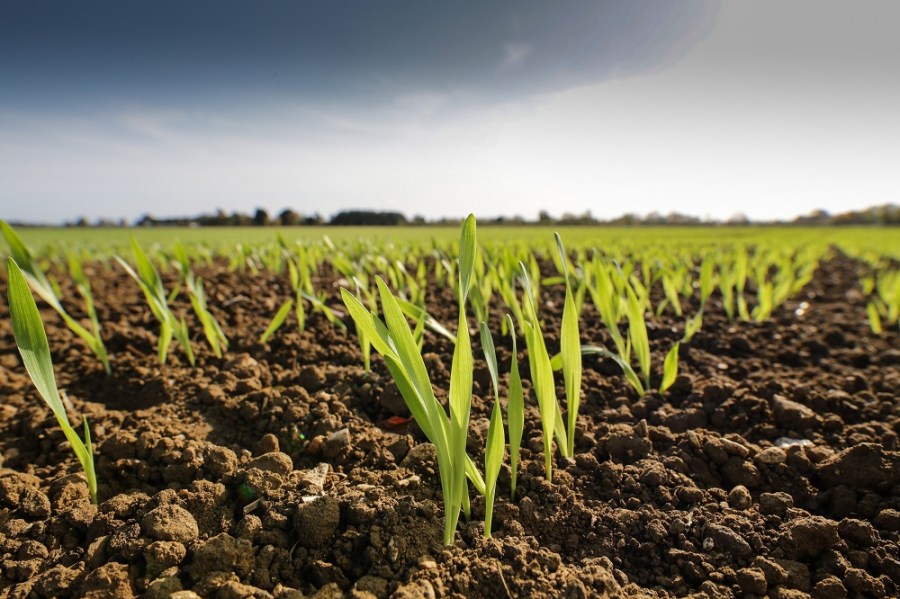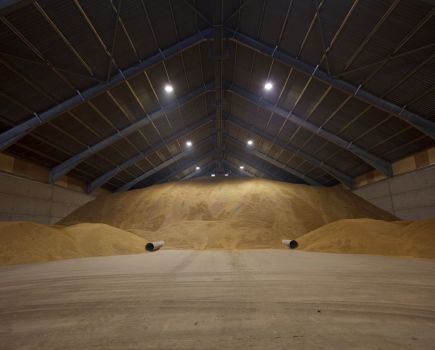A healthy crop needs a strong foundation and it’s at those early stages of a cereal and oilseed plants life where the right balance of nutrients is crucial. CPM assesses a young crop’s needs.
It’s not just helping the crop to withstand cold weather, it’s involved in the production of floret initials which occurs in the autumn.
By Andrew Blake
Autumn applications of foliar nutrients to oilseed rape and cereals could be more beneficial than some growers realise, according to FMC’s technical manager for crop nutrition, Charlie Bannister.
Elements such as boron, molybdenum for OSR, manganese, sulphur and zinc must be available early in those crops’ lives as well as later for them to perform to their full potential, he explains.

Elements such as boron, molybdenum, manganese, sulphur and zinc must be available early in a crop’s life for it to perform to its full potential.
“OSR’s need for boron was recognised and accepted several years ago. Generally speaking dicotyledons have a greater overall requirement than monocots and this is tied in with cell wall structure.
“Boron is important in the production of lignin which is an integral part of those cell walls. Scientific research shows that it encourages frost and cold tolerance which ties in with its role in lignin formation.
“In that respect it’s like manganese which is also required for producing lignin and improving cold tolerance.”
Although demand for boron in the autumn is less than in spring at stem extension when dry matter production is the key crop activity, a ready supply should be available at all times, urges Charlie.
“It’s not just helping the crop to withstand cold weather, it’s involved in the production of floret initials which occurs in the autumn.”
Boron is also thought to be associated with the production of phenols – compounds produced by the plant to reduce the effects of abiotic stress, he adds.
“Abiotic stress is caused by factors such as cold, drought, nutrient imbalance and salinity.
“I do think that more people are coming to appreciate the role played by bio-stimulants in reducing abiotic stress; and we’re involved with research institutes, like Shannon Applied Biotechnology Centre in Ireland and at some UK universities, looking at the effects on gene expression and the uplift of defence enzymes after applying Ascophyllum seaplant extract.”
Soil boron levels are probably declining, Charlie believes. “We’re now seeing low and deficient tissue tests in cereals which as a crop group are not considered particularly susceptible to boron deficiency, although it must be said that as one of the 17 essential elements boron is needed by all plants.
“Boron is held in the soil organic matter, and we know that organic matter levels in many arable fields are less than desirable. It’s also significantly affected by rainfall and will leach under certain conditions, for example when we experience heavy and persistent rainfall and especially on light land and low organic matter levels.
“Conversely in very dry conditions boron availability is significantly reduced because it needs water to move within the soil.”
Molybdenum also has an important role in OSR nutrition, says Charlie.
“It’s involved in the assimilation of nitrogen and sulphur, the latter being particularly important for a crop like OSR which contains lots of sulphur-based plant phenols.
“Our trials have shown that the best yield response comes from an autumn application of a boron-containing product followed by a spring treatment, and this fact would be particularly true where we’ve marginal levels of many of the essential elements.
“Autumn application is usually at the 4 to 6-leaf stage. This can be something like Bo-La which is a combination of boron and molybdenum and it’s often supplemented with other foliar nutrient products. Alternatively some growers opt for a more broad-spectrum approach using products like such as Boson or Zoom.
“Another one we’re looking at is foliar phosphate in the form of Hi-Phos or Peloton in both OSR and cereals in the autumn and early spring.
“Phosphate is such a quirky element in terms of its availability in and from the soil. So with pressure on to make better use of our phosphorus reserves and to reduce its environmental impact it’s something we’re researching in work at a university in Brazil which has the technology to track phosphate uptake into and through the leaf using the product Hi-Phos.”
Recently published academic papers from the University of Copenhagen, using the same methodology that has been used to show the effects of latent manganese deficiency, indicate that plants can be severely deficient in phosphate without the appearance of any symptoms, he notes.
“So we’re working with other universities in the UK and Europe using different technologies to see how foliar applied phosphate moves through the plant, and how readily it can be used to rectify that hidden phosphate deficiency.”
In cereals, autumn application of micronutrients, from GS13-21, primarily involves manganese, notes Charlie.
“However, our view is that we’re missing probable deficiencies of other elements like zinc and magnesium.
“Our work going back several years does indicate that zinc deficiency is prevalent alongside manganese shortage. The problem is that it’s less visual. You could say zinc deficiency is rarely seen but often found.”
Magnesium is an element usually associated with spring applications at GS 39-45 and even later, he notes.
“But published scientific research from Sabanci University in Turkey shows it’s important for root growth because it combines with adenosine triphosphate (ATP) to help transport carbohydrates around the plant, and magnesium deficiency leads to reduced root growth.
“This being the case I think we may need to rethink the timing of magnesium, and should be bringing it forward into the autumn as a combined foliar application certainly with manganese and maybe zinc.”
On soils particularly prone to manganese deficiency, such as in parts of the Vale of York, farmers need to be on early in the autumn and should be prepared to go again and again, advises Charlie.
“They should remember that manganese is not a great mover around the plant, so as new leaves are produced they’re not fully supplied. Applying manganese once in the autumn on deficient soils won’t always cover the problem.
“Manganese is so important to photosynthesis. In my view it’s the pivotal element especially when nutrient deficiency is apparent.
“Sure, magnesium is an integral part of chlorophyll, but its deficiency is exhibited in other processes before photosynthesis, whereas deficient manganese directly affects photosynthesis.
“The strange thing is that manganese deficiency has a significant effect on photosynthetic efficiency, but it’s not until that effect is particularly severe that we see the symptoms.”
Early foliar strategy helps crops weather the winter
Feeding the crops well and early on in their lives is essential, according to Scott Colclough an agronomist for ProCam UK in north-east Yorks. In that respect autumn foliar micronutrient applications are “massively important”, he says.
“They’re needed to help crops develop well and to keep them healthy which allows them to protect themselves over winter.”
Scott has 12 years of experience of working with a wide range of crops – cereals, OSR, sugar beet, peas, beans and potatoes.
“It’s been over most soil types – deep clay, clay loam, sandy loam, deep silt, light sand and some peat land.”
Ensuring excessive soil acidity or alkalinity doesn’t restrict nutrient accessibility is particularly important, he stresses.
Achieving a good pH balance by using satellite-guided soil sampling and then applying lime variably has brought significant benefits to his farmer customers, he believes. “It’s been helping to improve an overall nutrient availability.”
Manganese deficiency in wheat and barley grown on light land can be a particular problem, he says.
“We help prevent it by having a good firm seed-bed along with more than one application of manganese early in the crop’s growth.
“In some cases having to two to three applications of manganese has been crucial, as is using the more persistent types of foliar manganese. But it’s important not to apply manganese to young lush cereal plants before a frost.”
Poor phosphate availability for OSR grown on his lighter land is another potential problem.
“We counter that by applying di-ammonium phosphate before or at drilling, which also improves rooting. We then follow post-emergence with a foliar phosphate application, and I also find adding a bio-stimulant helps.
“We’ve seen a benefit against flea beetle and an improvement in yield.”
Some of his soils are increasingly boron-deficient due to lack of organic matter. So where that’s likely he recommends corrective autumn foliar treatments with FMC Promo. “It contains boron along with molybdenum which is an important nutrient that needs to be applied early during OSR growth.”
Autumn foliar manganese essential on Yorks sandland barleys
For NIAB-TAG agronomist Julian Thirsk one autumn foliar-applied element in particular – manganese – is vital for cereal crops, more so on the family farm near Selby in North Yorks along with the lighter soils within the York area.
“We’ve farmed here since 1972 and have 325ha of land on a mixture of light Wigton Moor series soils and heavier Romney series. We grow winter wheat, winter barley and oilseed rape, sugar beet and combining peas.”
As an adviser Julian is also involved with potatoes, beans and maize in Yorks up to Northumberland grown on soils ranging from blow-away sand and brash to heavy land. “We have a multitude of soils within this area.
“The main nutrient problem is manganese deficiency in the autumn mainly on the light land winter barleys. We need to treat with manganese sulphate every 21 days otherwise the plants will eventually die.”
This continues well into the spring with cold temperatures followed by warmer weather bringing out manganese deficiency symptoms very quickly, he points out.
Nutrient nurture
An appreciation of the importance of crop nutrition and the need to understand its multifaceted nature are essential to optimise crop performance. In this sponsored series, CPM has teamed up with FMC to explore the individual elements needed for crop growth and the factors which apply individually to each element.
From functions within the plant to behaviour in the soil, antagonism, synergies, environmental impacts and limiting factors, these articles seek to unlock the answers and facilitate sustainable increases in crop yield and quality.
 FMC supplies an extensive range of foliar nutrition products, encompassing those containing single elements to more complex multi-element products formulated to meets differing crop demands. FMC is also the market leader in the manufacture and supply of foliar nutrition products using humic technology, nitrate salts and advanced surfactant/suspension systems delivering rapid uptake and utilisation of elements by the plant.
FMC supplies an extensive range of foliar nutrition products, encompassing those containing single elements to more complex multi-element products formulated to meets differing crop demands. FMC is also the market leader in the manufacture and supply of foliar nutrition products using humic technology, nitrate salts and advanced surfactant/suspension systems delivering rapid uptake and utilisation of elements by the plant.




